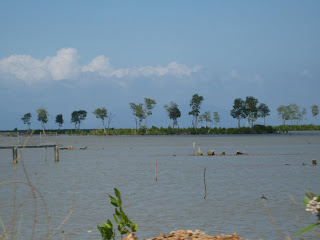
1. Apparently the year 2009 began at about 2401 hr on the 1st January 2009 and it is going to end with some celebrations at Dataran Merdeka at about 2359 hr to-night on 31st December 2009. I hope the new year will come as planned!
2. The year 2009 is not that memorable at all to me as there are nothing much to savour and remember except:
a) I didn't enjoy teaching botany and biology very much. The undergraduates and postgraduates were not that ready intellectually to embark on their studies. They didn't read much and they were far from being critical with their science either. I feel the teaching of biology in pre-university curriculum is much to be desired and the teaching of biology in first degree curriculum is no better either.
b) I didn't enjoy supervising the students either. Many expected spoon-speedings and wanted to be told of every things they should do and shouldn't do. I have more difficulties supervising foreign students because of their poor English, poor biology and some of them are too lazy to work. Some of them are excellent though and a joy to have them around. However, in 2009 I have 8 PhD students and 14 MS students to supervise, in addition to three final year students.
c) I have no research grant. The ones I applied for failed to get support from those who evaluated my proposals. Hence I don't have funds to support my students. What a crazy world that a professor emeritus has no research grants!
d) I have not been productive academically. I produced only 3 papers in scientific journals and a dozen of papers in local and international proceedings. However, I helped to edit and write texts for 7 beautiful Coffee table books and edit 2 proceedings for Department of Forestry Peninsular Malaysia and other popular books and proceedings.
e) I did enjoy contributing to the society via WWF Malaysia as Chair, Pulau Banding Foundation as Chair, Orang Utan Island Foundation as a Trustee, Malaysian Timber Certification Council as a Trustee, Academy Science Malaysia as a Fellow etc,
f) I was invited as either a Keynote speaker or a Plenary speaker for 15 conferences, mostly national, some at university level and only one at International level. I enjoyed speaking to the young scientists.
3. Mypersonal health is like a yo-yo, sometimes I feel great and sometimes I feel quite bad and fatigue. My friends thought it was because of my age. I am still taking glucovance for my diabetes and zocol for my cholesterol, in addition to some vitamins and food supplements. I am beginning to sleep earlier than usual but in the day time I could work from 0800 hr to 1830 hr without any complaints. My routine breakfast is still a piece of toast, coffee and warm water, sometimes bananas; my lunch is mostly tosyei and my dinner is anything goes.
4. My children and grandchildren are doing just great. Abe has started teaching at UPM after his reading for his PhD at John Morse University at Liverpool; Awa is enjoying his works at Manchester; Lalan is exhausted drawing plans for others; Tina is progressing well with her PhD works, Hakim is yet to be called by MAS, Yasmin is in her final year at UiTM Melaka and Amir is going to Form 5. Next year i.e. 2010 Ilyas is attending year 1 at Sekolah Section 7 and Sarah is going to a local pre-school.
5. My two sisters Latifah and Safinah in Kelantan are getting healthier than last year and my only brother the Giant Yu is still traveling all over the world as a TV3 photographer. My in-laws, nephews, nieces and other waris are fine too. I hope they continue to be happier and healthier in 2010.
6. The number of cars in the house has increased by two; the petrol bills, water bills, electricity bills, telephone bills and other bills also increased. This is not sustainable and environmentally friendly. We should decrease our foot prints by at least 10%.
7. What are my New Year resolutions? None this year.














